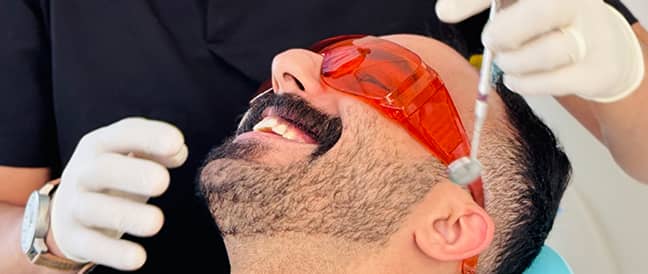Have Questions?
We’ve got you covered with solutions and answers to your common dental concerns.

Find a solution
Having missing teeth can significantly impact both oral and overall health, as well as hinder comfortable eating and speaking. Whether you seek to replace a lost tooth or enhance the overall appearance of your smile, we provide various treatment options. From dental implants to fixed dental bridges or removable partial dentures, we offer a comprehensive range of solutions with the highest quality standards to meet your needs. At 965Smile, we pride ourselves on using exclusively [Swiss Implants] (insert name of product), which are recognized worldwide for their exceptional quality and durability.
Begin the journey to reclaiming your smile. Contact us to explore your replacement options
Over time, dentures undergo wear and tear, just like natural teeth. Discomfort, gum irritation, and chewing difficulties that have developed over time may signal the need for new dentures. Other signs, such as chipping, cracking, or severe stains, also indicate that it’s time to replace your dentures. Dentures may also require replacement due to inadequate care or accidents, such as dropping.
If you’re considering replacement, we’re ready to guide you through the decision-making process. Schedule an appointment with us at your convenience, here.
Periodontitis is a severe type of gum disease. It starts with the inflammation of the gums, which show up as redness, bleeding, or swelling. Left untreated, it can result in tooth loss. Treatment options vary based on the severity of the condition. They range from nonsurgical procedures like antibiotics and deep dental cleaning, to surgical intervention. Periodontitis can be managed effectively with early intervention, as well as proper care and treatment. Contact us to discuss your personalized treatment and maintenance plan. Schedule an appointment today.
Want a smile that turns heads? A beautiful, natural smile requires a delicate balance of artistry and scientific precision, ensuring both aesthetic appeal and functional durability. Cosmetic dentistry is all about achieving this balance. At 965Smile, we offer a range of cosmetic treatments including veneers, crowns, bridges, tooth-colored fillings, implants, and teeth whitening. Our specialized approach to cosmetic dentistry ensures that the allure of your authentic smile shines through. With a dazzling smile, your confidence is sure to receive a significant boost. Are you ready for this life-changing transformation? Contact us now to take the first step toward achieving the radiant smile of your dreams!

